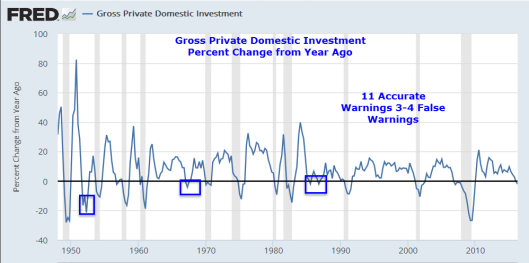Yesterday the BEA released its Third Estimate for Second Quarter GDP.
The third (final) estimate bumped up the prior estimate from 1.1% to 1.4%. The BEA changed the name from final to third because GDP is subject to revisions years or even decades later.
Diving into the report we see “Real Gross Domestic Income ” GDI went from +0.2% to -0.2%. Is that significant? Let’s take a look.
Third Estimate of Second Quarter GDP

DI and GDP are two measures of the same thing. Over time they equal. Since the data sources are different, they frequently diverge for a while.
Business Insider has a nice article that explains the difference: FORGET GDP: Here’s the new way Wall Street is measuring the US economy.
Note: The following snips are from May 30, 2015. The generalities are correct, the assessments as to what are happening now are incorrect.
The basic difference between the two is that GDP measures what the economy produces — goods, services, technology, intellectual property — while GDI measures what the economy makes, tracking things like wages, profits, and taxes.
Why GDI?
There are actual, substantive reasons for economists and market participants to focus on GDI rather than the traditional GDP number. In theory, the two numbers should be the same, as both are designed to measure the aggregate growth of the economy. GDP measures what the economy produces, GDI measures what it takes in.
But because they use different data sources, these readings are subject to measurement error, though the BEA notes they tend to follow similar paths over time.
A main difference in their inputs is tax receipts, with GDI taking into account taxes on production and imports, as well as subsidies, net interest, and miscellaneous payments.
Since the financial crisis, first-quarter GDP has consistently lagged growth during the second, third, and fourth quarters. And the whole point of the government “seasonally adjusting” the data is to smooth out these variances and give markets and the public a more reliable, consistent picture of the country’s economic health. Given the repeated failures of the first quarter to be anything other than a disappointment, it seemed that something was off.
As currently tabulated, GDP was a big disappointment in the first quarter. As currently tabulated, GDI showed an economy that is still growing.
And with lingering issues around how the government adjusts its GDP data, Deutsche Bank’s LaVorgna argued in a note on Friday, “the drop-off in estimated Q1 GDP growth has not altered our view that the underlying fundamentals of the economy remain on firm footing.“
Real GDI
As noted above, the Business Insider article was written May 30, 2015. Suddenly, there’s silence. This is why …

Whereas real GDP was revised up 0.3 percentage points, real GDI was revised lower by 0.4 percentage points, to -0.2%.
A quick glance at the recession bars in the above chart shows what negative GDI numbers traditionally mean.
Real Private Gross Domestic Investment
Real private investment (not to be confused with income) is a measure of investment in the real economy, not under the influence of massive amounts of government spending. The numbers are not pretty.

Government Spending
Government spending adds to GDP, by definition. Here’s the example I frequently use: If the government paid people to spit at the moon, it would add to GDP.
Real gross private investment normally accounts for only 13-16% or so of GDP. Private investment is a very volatile portion of GDP.
Wikipedia comments …”Gross private domestic investment is the measure of physical investment used in computing GDP in the measurement of nations’ economic activity. It provides an indicator of the future productive capacity of the economy. It includes replacement purchases plus net additions to capital assets plus investments in inventories. From 2002-2011 it amounted to 14.9% of US GDP, and from 1945-2011 was 15.7% of GDP (BEA, USDC, 2013). Net investment is gross investment minus depreciation. Of the four categories of GDP (investment, consumption, net exports, and government spending on goods and services) it is by far the least stable.”
The charts speak for themselves.
